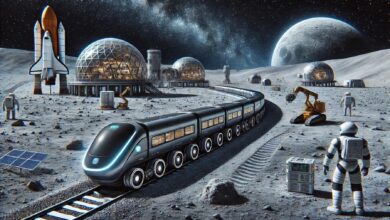The Economics of Asteroid Mining and Its Future Profitability

Asteroid mining is emerging as a potentially transformative industry that could redefine the economics of space exploration and resource extraction. With the technological advancements in space travel and robotics, mining asteroids for valuable resources like metals and water is becoming increasingly feasible. This article explores the economic aspects of asteroid mining, its potential profitability, and the challenges and opportunities that lie ahead.
The Concept of Asteroid Mining
Asteroid mining involves extracting valuable materials from asteroids, which are abundant in the solar system. These materials include precious metals like platinum and gold, industrial metals such as iron and nickel, and volatiles like water and helium-3. The prospect of accessing these resources has garnered significant interest due to the limitations of terrestrial mining and the growing demand for these materials in various industries, including electronics, energy, and aerospace.
Economic Potential of Asteroid Mining
Resource Value
- Precious Metals: Asteroids are rich in precious metals, which are essential for numerous industrial applications. For instance, a single asteroid like 16 Psyche is estimated to contain metals worth over $10,000 quadrillion, including vast amounts of platinum and gold. This potential treasure trove could dramatically impact global supply and pricing of these metals.
- Industrial Metals: Metals such as iron, nickel, and cobalt are critical for manufacturing and construction. Asteroids can provide a nearly limitless supply of these materials, reducing the need for environmentally damaging mining practices on Earth.
- Water and Volatiles: Water is crucial for life support and as a raw material for producing rocket fuel (through the electrolysis of water into hydrogen and oxygen). Extracting water from asteroids could support long-duration space missions and establish fuel depots in space, significantly lowering the cost of space exploration.
Market Demand
The demand for the resources found in asteroids is expected to grow as technology advances and new applications emerge. Precious metals are essential for electronics and renewable energy technologies, while industrial metals are needed for construction and manufacturing. Water and volatiles will become increasingly valuable as human presence in space expands, supporting life support systems and in-space manufacturing.
Key Players in Asteroid Mining
Several companies and organizations are leading the charge in asteroid mining, each with unique approaches and technologies.
- Planetary Resources: This company focuses on developing technologies to identify and mine asteroids for precious metals and water. They aim to create a space economy by making space resources accessible and affordable.
- Deep Space Industries (DSI): DSI develops spacecraft and technologies to extract resources from asteroids. They are working on small, low-cost spacecraft for prospecting and mining operations.
- NASA: The U.S. space agency is heavily involved in developing technologies for space exploration and mining. NASA’s OSIRIS-REx mission, which successfully collected samples from the asteroid Bennu, is a significant milestone in asteroid mining research.
- European Space Agency (ESA): ESA is exploring the potential of space resources through initiatives like the Space Resources Initiative, which aims to identify and utilize resources from the Moon and asteroids.
Investment Strategies in Asteroid Mining
Investing in asteroid mining involves various strategies, each with different levels of risk and potential return.
- Direct Investment in Companies: Investing directly in companies developing asteroid mining technologies and missions is a straightforward approach. This includes buying stocks of public companies or investing in private companies through venture capital.
- Investment in Related Technologies: Companies that develop enabling technologies for asteroid mining, such as robotics, AI, and space transportation, also present investment opportunities. These technologies are critical for the success of asteroid mining operations.
- Exchange-Traded Funds (ETFs): ETFs focusing on space exploration and technology can provide diversified exposure to the asteroid mining industry. Examples include the SPDR S&P Kensho Final Frontiers ETF (ROKT) and the Procure Space ETF (UFO).
- Government Bonds and Grants: Some governments may issue bonds or provide grants to support space mining initiatives. Investing in these can offer a lower-risk way to participate in the sector.
How to Invest in Space Mining
Investing in space mining involves several strategies, each with varying levels of risk and potential return. Directly investing in companies that are developing space mining technologies and missions is a straightforward approach. Look for publicly traded companies or invest in private companies through venture capital funds. Additionally, investing in related technologies such as robotics, artificial intelligence, and space transportation can provide exposure to the industry. Exchange-traded funds (ETFs) focusing on space exploration, like the SPDR S&P Kensho Final Frontiers ETF (ROKT) or the Procure Space ETF (UFO), offer diversified investment options. Lastly, consider supporting government bonds or grants that fund space mining initiatives, providing a lower-risk investment with potential returns tied to the growth of this emerging sector.
By combining these strategies, investors can effectively participate in the potential growth of the space mining industry, positioning themselves to benefit from its long-term economic impact and technological advancements.
Economic and Technical Challenges
While the potential rewards of asteroid mining are significant, there are considerable challenges that must be addressed.
- Technological Development: Extracting resources from asteroids requires advanced technologies, including autonomous robotic systems, precision landing and navigation, and in-space processing capabilities. Developing and deploying these technologies is costly and technically challenging.
- High Initial Costs: The upfront costs of asteroid mining missions, including the development of spacecraft, launch services, and mining equipment, are substantial. These costs need to be justified by the potential return on investment, which may take years to realize.
- Regulatory and Legal Issues: The legal framework for asteroid mining is still evolving. Issues related to property rights, international agreements, and environmental impact need to be addressed to ensure the sustainable and equitable development of space resources.
- Market Volatility: The space mining industry is still in its infancy, and market conditions can be highly volatile. Investors must be prepared for potential fluctuations in the value of their investments.
Profitability of Asteroid Mining
Cost-Benefit Analysis
- Cost Reduction Through Technology: Advances in technology, particularly in reusable rockets and autonomous robotics, are expected to reduce the costs of space missions significantly. Companies like SpaceX have already demonstrated the feasibility of reducing launch costs through reusable rocket technology.
- Resource Abundance: The abundance of resources on asteroids can potentially drive down the costs of these materials on Earth, making previously economically unviable resources accessible.
- Long-Term Investment: Asteroid mining is a long-term investment. While the initial costs are high, the potential returns are substantial, especially as technology matures and the demand for space resources grows.
Revenue Streams
- Selling Extracted Resources: The primary revenue stream for asteroid mining companies will be selling the extracted resources, including precious and industrial metals and water.
- In-Space Services: Companies can also generate revenue by providing in-space services, such as fuel depots for spacecraft, life support supplies, and materials for in-space manufacturing.
- Intellectual Property and Technology Licensing: Developing cutting-edge technologies for asteroid mining can create additional revenue streams through intellectual property rights and technology licensing agreements.
Future Prospects of Asteroid Mining
Technological Advancements
- Autonomous Robotics: Continued advancements in autonomous robotics will enable more efficient and cost-effective mining operations. These robots can operate in harsh environments, reducing the need for human intervention.
- In-Space Manufacturing: In-space manufacturing technologies will allow the processing and utilization of resources directly in space, reducing the need to transport materials back to Earth.
- Space Transportation: Improvements in space transportation, particularly reusable rockets and advanced propulsion systems, will lower the cost of accessing and transporting resources from space.
Economic Impact
- Global Supply Chains: Asteroid mining has the potential to disrupt global supply chains by providing a new source of raw materials. This could reduce dependency on terrestrial mining and lower the environmental impact of resource extraction.
- New Industries and Jobs: The development of the space mining industry will create new industries and jobs, driving economic growth and innovation.
- Sustainable Development: Access to abundant space resources can support sustainable development by providing the materials needed for renewable energy technologies, construction, and manufacturing.
International Collaboration
- Global Partnerships: Collaborative efforts between countries and space agencies will accelerate the development of space mining capabilities and establish a legal and regulatory framework for the industry.
- Regulatory Frameworks: Developing international regulatory frameworks to govern the extraction, transport, and use of space resources is crucial for ensuring equitable access and preventing conflicts.
Conclusion
Asteroid mining presents a unique opportunity to revolutionize resource extraction and drive economic growth through technological innovation. While the industry is still in its early stages, the potential rewards are significant, and advancements in technology are bringing the prospect of space mining closer to reality. By understanding the economic potential, key players, investment strategies, and challenges involved, investors can make informed decisions and position themselves to benefit from the growth of this exciting industry.
References
- “Asteroid Mining Could Be Worth Trillions of Dollars.” Forbes. Forbes.com
- “Planetary Resources: The Asteroid Mining Company.” Planetaryresources.com
- “Deep Space Industries: Pioneering Space Resources.” Dsi.as
- “NASA’s OSIRIS-REx Mission.” NASA.gov
- “ESA’s Space Resources Strategy.” ESA.int



